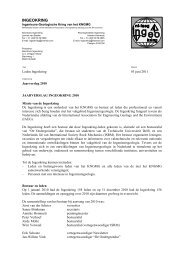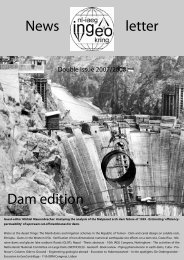environment
environment
environment
- No tags were found...
Create successful ePaper yourself
Turn your PDF publications into a flip-book with our unique Google optimized e-Paper software.
Ingeokring Newsletter<br />
Abstract thesis Subodh<br />
Dhakal<br />
ITC<br />
Empirical relations for earthquake response of slopes<br />
The finite difference program FLAC is used to find the<br />
relationships between the slope geometry, earthquake<br />
input signals (mainly frequency of the wave) and the<br />
material properties of the slope on the amplification of<br />
vibration on the surface. A sinusoidal wave with<br />
acceleration of 1 m/s 2 , input frequency of 5 Hz and<br />
amplitude of 1 m is applied for the duration of 0.25 sec in<br />
the first three models used for the calculations. For the<br />
fourth model, however influence of varying input<br />
frequencies is also investigated applying the input<br />
frequencies of 3 Hz, 5 Hz, 10 Hz and 15 Hz. Other material<br />
properties are varied whenever necessary to examine<br />
the response of that particular material properties. The<br />
response of three models are first observed before the<br />
simulation of the last model, the response of which is to<br />
be used for finding out the relationship between the<br />
input parameters and the amplification. The first three<br />
models revealed that the edge of the slope crest is<br />
generally more vulnerable for amplification than farther<br />
away from it as in most of the cases the magnitude of<br />
amplification at the edge of the slope crest is more than<br />
that farther away. Regarding the influence of the slope<br />
angle, friction angle, and the material cohesion, the first<br />
three models show that if the slope angle is higher than<br />
the friction angle, the slope starts to fail when the<br />
material cohesion is not enough to resist the slope. In<br />
addition, the response of the slope after it fails is very<br />
different to that before it fails.<br />
Simulation with the fourth model show that higher slopes<br />
are amplified most by the lower input frequency whereas<br />
the reverse is true for the smaller slopes. The overall<br />
magnitude of the amplification is maximum with input<br />
signals of higher frequency and lower slope heights.<br />
The horizontal amplification as much as 17 are obtained<br />
for the normal limestone slope with 20 m height when<br />
an input signal of 15 Hz frequency is applied. The<br />
amplification peaks repeat for the same input frequency<br />
but for different slope heights. It is considered reflection<br />
of the harmonic effect. The exact effect of bulk modulus<br />
however could not be found out, as the relationship<br />
could not be explained properly. A clear resonance effect<br />
is seen when the amplification is plotted against the<br />
shear modulus as well as against the ratio of the slope<br />
height to wavelength of the input signals. The slope<br />
height to wavelength ratio of 0.07 to 0.23 is seen to be<br />
most vulnerable for seismic amplification. The horizontal<br />
amplifications in the order of 6.5 are obtained for that<br />
range of slope height to wavelength ratio. The<br />
generation of standing waves at certain harmonic<br />
frequencies could be the reason behind such a high<br />
amplification. An empirical function is recommended to<br />
show the relation of slope height, shear wave velocity<br />
and the input frequency on amplification. This type of<br />
relationship is believed to have great importance for<br />
seismic microzonation study as the results might be<br />
used along with the digital elevation model for separating<br />
different zones of hazard levels. However, one should<br />
be aware that the relationship is for the particular<br />
combination of material properties and slope geometry<br />
and the generalization for all type of materials might<br />
give misleading results.<br />
Abstract thesis<br />
Getachew Lemessa Fufa<br />
ITC<br />
Reliability or Likelihood of Geological or Geotechnical<br />
Models<br />
Nowadays, the likelihood of a subsurface geological<br />
model is becoming a very critical concern to geoscientists<br />
because the decisions on investments require accurate<br />
models and quantification of the economic and business<br />
risks.<br />
The aim of this research is to build multi 3D models<br />
based on semantic approaches, and assess and evaluate<br />
factors affecting the reliability or likelihood of a<br />
geological or geo-technical model. The data set of the<br />
Reeuwijk road project, Western part of The Netherlands,<br />
obtained from NITG-TNO (Netherlands Institute of<br />
Applied Geosciences) has been used. The 63 shallow<br />
borehole data were selected covering an area of 3.2 km 2 .<br />
Holocene and Pleistocene clay, peat and sand are the<br />
main sediments. By an integration of geo knowledge<br />
acquired from multiple data sources such as previous<br />
reports, geological and geo-technical maps and<br />
sections, the conceptual framework has been designed<br />
for guiding interpretations of the down hole data in<br />
assisting the modelling process. In the course of the<br />
modelling approach, different possible ways of<br />
presenting the lithology units and lithostratigraphic<br />
formations were used and as a result four different types<br />
of models have been produced which each can be used<br />
for different purposes, and are executed by the<br />
lithological modelling and stratigraphic modelling<br />
respectively in Rock works 2002.<br />
In this research work, methodology is formulated that<br />
could help in the evaluation of the likelihood of the G 2<br />
models. These might be pursued by two ways: one<br />
qualitative and one quantitative.<br />
64




